When recording music, podcasts, or digital audio, the gateway to quality is often an audio interface. This device allows you to capture sound and convert it into a format that your computer can use.
It acts as a bridge between microphones, instruments, and the digital realm.
Think of it as the centerpiece of your home studio setup or mobile recording rig, converting sonic nuances into electronic signals with clarity and precision.
Whether you’re a professional producer or a home studio enthusiast, we know that finding the perfect audio interface to fit your recording needs is crucial.
Best Audio Interface for Home Studio
1. Universal Audio Apollo Twin X DUO
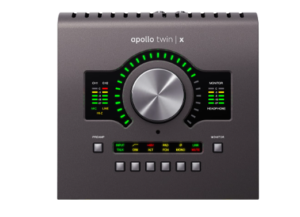
In the world of plug-ins, Universal Audio is a legend. Award-winning producers and bedroom studio engineers alike love the rich warmth that Universal Audio sound delivers.
For serious recording enthusiasts, the Universal Audio Apollo Twin X Duo USB Heritage Edition is a game changer with its unparalleled audio conversion quality.
Recording through this interface feels like a mix of analog warmth and digital precision. That’s a rare thing.
The brand’s compressors and EQs are unrivaled in providing an analog simulation experience that rivals the best hardware, so I expected the Apollo Twin MkII to be a blast.
While Universal Audio’s more powerful Apollo 8 and 16 models are the industry’s go-to solutions for top-quality audio, I think the Apollo Twin X has managed to slip under the radar.
This interface packs a punch at a lower price point and includes the ability to double as a DSP box. Plus, I’m blown away by the included Unison preamps, which I’ve heard a lot about from others in the industry.
These Unison preamps model the classic sounds of a variety of vintage gear, and I’ll be the first to admit that I can’t tell the difference between the real thing and the modeled stuff.
It’s great! This technology leverages the combined talents and technologies of brands like Neve, Manley, SSL, and API to create the unique analog sound that’s been found on many a hit record over the years.
Whatever I recorded with this interface, sounded smooth and clear, with a sweet, warm feel. Vocals sounded like butter, and guitars and keys, both analog and digital, sparkled beneath the sweetness of analog.
The build quality of this unit is solid, with the durability and quality you expect from the Universal Audio brand. The included Heritage Edition plug-in lets you create professional-level mixes.
The fact that it’s calibrated for Windows might be a downside for some, but for those in the ecosystem, this interface is a solid choice.
2. Focusrite Scarlett 18i20
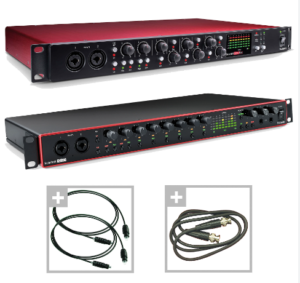
Recommended for full bands and project studios Focusrite Scarlett 18i20 The Focusrite Scarlett 18i20 may be one of the most popular interfaces for project studios.
And for good reason. It offers a ton of features and expandability that will keep you going for years.
This interface provides eight XLR/¼” inputs for tracking drums or larger full-band sessions. Like other Scarlett devices, the 18i20 features Focusrite’s “Air” technology.
There’s also a pad to lower the gain of louder-sounding sources. It also features optical and S/PDIF connections.
This allows you to easily connect external preamps, instruments, or effects devices – a huge plus if you need more inputs! On the output side, you’ve got ten line outputs, including two for a pair of monitors.
There are also two headphone jacks and an optical output on the front.
There’s also talkback functionality, monitoring tools, word clock output and MIDI in/out. This is a fully featured interface that’s perfect for a project studio – or anyone looking to record a full drum set or a full band.
3. Focusrite Scarlett 4i4 4th Gen
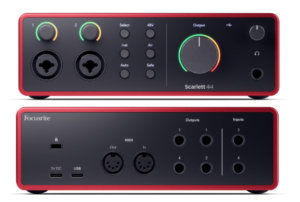
The Scarlett 4i4’s unique selling point lies in its incredibly transparent preamplifier.
This preamplifier allows you to capture the true tone of your instrument or voice without any additional noise or coloration, making it a game-changer for both amateur and professional projects.
The 4i4 offers enough connectivity for a decent home studio setup, easily accommodating microphones, instruments, and MIDI devices.
It would have been nice to have an additional headphone out for dual monitoring, but given the compact size and price point of the device, this is acceptable.
The bundled software is a treasure trove of tools that encourage creativity and provide what would otherwise be a significant additional investment.
Whether recording podcasts, music, or other multimedia content, the 4i4’s reliability and clarity of sound never let us down.
If I had to sum up my journey with the Scarlett 4i4 in a few words, it would be ‘effortless professionalism’.
As we wrap up our time with the 4i4, it has more than justified its reputation and position in the audio interface market.
4. Audient iD44
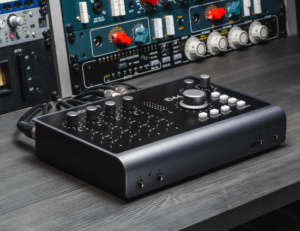
Recommended for Full Band and Project Studios Audient id44 Need an affordable interface that can scale? You can’t get a better option than the Audient iD44.
It has four XLR and ¼” inputs. You can also add a whopping 16 audio channels via the two optical inputs on the back. The four onboard inputs all feature phantom power, pads, and high-pass functionality.
The first two inputs on this interface also feature insert functions. This allows you to send your audio through effects before it is converted to your computer.
This is great if you want to apply compression or EQ while you are at it. The iD44 also has two headphone outputs.
These are conveniently located on the front of the unit for monitoring and playback.
Finally, there is a great monitoring system with talkback for the headphones, a large volume knob, and dim and cut functions.
This is a fantastic-sounding device. It would be a great addition to any growing project studio or band’s arsenal.
5. Zen Go Synergy Core 4×8
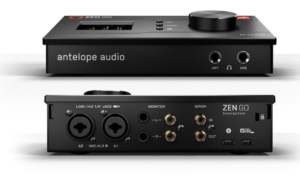
The Zen Go Synergy Core is a sleek and powerful interface that fits into your desktop space.
I was really impressed with the design, and while I haven’t dealt with much Antelope gear in the past, I think the brand is one to watch.
I think Antelope is not everyone’s go-to “big box” brand, but they are a boutique brand in that they approach audio processing from an angle that favors quality and character over volume.
A smaller version of Antelope’s Zen Studio interface, the Zen Go Synergy Core interface offers a scaled-down experience that still delivers powerful performance.
What I really like about this interface is that it is loaded with onboard DSP effects, including amp simulators, compressors, and cabinet simulations.
The included DSP allows you to shape your sound before it even gets to your DAW, which ultimately saves a lot of processing power.
The Zen Go Synergy Core only has two physical inputs, but it can handle up to eight inputs and outputs to your DAW using USB-C.
This is very convenient for applying DSP effects to existing tracks and saves time routing cables.
During my testing, the raw audio, without any DSP applied, sounded clear and concise, with no coloration.
I usually like interfaces that offer a bit of warmth, but it’s also a good idea to work with a clean signal so you can hear exactly what’s being delivered.
Overall, the Zen Go Synergy Core is a perfect solution for small studio spaces or travel, and its price point seems to fit well into mid-production budgets.
6. PreSonus AudioBox USB 96
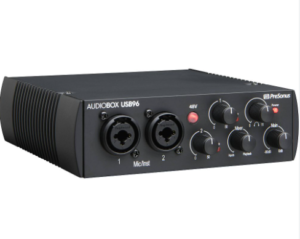
The PreSonus AudioBox 96 stands out for its ability to turn a simple laptop into a mobile recording studio.
The combination of its durable construction and its valuable software suite makes it a great choice for both beginners and experienced users.
The PreSonus Audiobox USB 96 is a classic and very simple USB audio interface. This product features two high-quality preamps with jacks that accept XLR and ¼” inputs.
Perfect for recording piano or DI electric guitar. In addition to the analog inputs, you can also connect MIDI devices on the rear.
The AudioBox features two line outputs for studio monitors and a headphone jack. It has an all-metal construction and small size.
This makes this interface a great choice for recording on the go. It is also perfect for singer-songwriters or anyone who doesn’t record more than one thing at a time.
Overall, AudioBox 96 from PreSonus stands out as a solid entry-level interface.
Given its low price, portability, and comprehensive software bundle, it’s hard to beat for anyone looking to get started on their recording journey.
If you can overlook its minor limitations, this interface can be a compact powerhouse that can capture your creativity wherever you are.
7. Roland Octa-Capture

Recommended for full band and mobile recording Roland Octa-CaptureTalk about saving money.
The Roland Octa-Capture has a ton of features you’d normally find in more expensive interfaces. With eight XLR and ¼” inputs, you can easily record an entire drum set with the Octa-Capture.
Auto-sens even set the levels to save you valuable time.
Each input has its own high-pass filter, phase inverter, and compressor.
There are plenty of tools to tweak the tone of your instrument. Not to mention the preamp! Despite its low price and high input count, this preamp sounds really good.
As for outputs, the Octa-Capture has a headphone jack and eight TRS outputs. The Octa-Capture also lets you set up four different monitor mixes.
So if you want to track a whole band and have everyone have a different headphone mix, you can do that!
Need more inputs? You can combine two Octa-Captures with a coax cable. That’s double the number of inputs. This interface is packed with features.
It’s perfect for anyone looking to record a lot of instruments without spending a ton of money.
8. Scarlett Focusrite 2i2 4th Generation
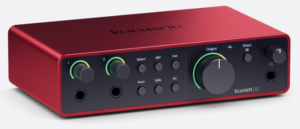
The Focusrite Scarlett 2i2 is a great choice for the home studio market. The world’s best-selling audio interface.
This 4th generation 2-input, 2-output USB-C interface delivers detailed, clear sound suitable for a wide range of instruments and vocals.
The striking and distinctive red aluminum case sets the Scarlett range apart in terms of both appearance and quality. The handle is sturdy and features a ‘gain halo’ instead of a traditional LED meter.
On the front panel are two TRS jack sockets for line inputs (mixers and audio gear).
You can also press the ‘Inst’ button to connect instruments such as electric guitars that require a little more gain. Each socket has a rotary dial to set the optimal gain.
But what if you’re new to audio and don’t want to worry about gain settings? Just press the ‘Auto Gain’ button and the 2i2 will set the levels for you.
If you’re worried about your mic levels being too high, the ‘Clip Safe’ button will automatically reduce the gain when it senses that it’s about to overload.
There are a few other features that can help you improve the sound of your mic or instrument. The ‘Air Presence’ button and the ‘Air Presence & Drive’ button.
As with the 3rd generation 2i2, Air Presence adds an airy quality, opening up the space at higher frequencies to add clarity and detail. It can sound great on vocals and acoustic guitars.
New to the 4th generation Scarlett 2i2 is the addition of ‘Air Presence & Harmonic Drive’.
In addition to subtly boosting the higher frequencies, it boosts the bass to add classic analog warmth and drive to the audio signal.
On the rear panel are two XLR inputs for microphones and two 1/4-inch jacks to power your studio monitors.
There is also a USB-C socket for connecting to a computer and a power socket for using the 2i2 as a standalone device.
The digitally controlled preamps are a huge improvement over the 3rd generation, delivering incredible detail and clarity on a wide range of microphones.
With a massive 69dB gain range, the Scarlett 2i2 4th Generation will be a great fit for any type of mic input, including low-level dynamic mics like the SM7B or SM58.
9. Steinberg UR44
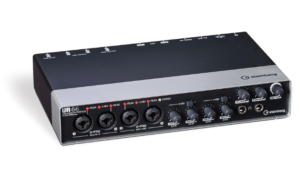
Recommended for full bands and project studios Steinberg UR44 Audio Interface The Steinberg UR44 is an interface with four high-quality preamps.
This interface also has two dedicated line inputs on the rear. This is great if you want to use external preamps.
You can plug them directly into the interface without any coloration of the sound. The UR44 has a ton of output options.
There’s a main out for monitoring, and four separate outs that can be used for headphone amps or effects devices.
There are also two headphone outputs on the front. This is perfect if you need another pair of ears to listen to while recording or tracking someone else!
Finally, this interface also has MIDI In and Out for all your digital instrument needs. This is a feature-packed interface that’s great for anyone tracking a band.
10. Arturia AudioFuse
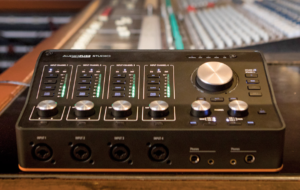
Arturia’s digital audio products have been used by everyone from Trent Reznor to Alan Parsons, and the brand creates incredibly convincing analog simulations with its entire line of vintage synth plug-ins.
Arturia also makes a number of MIDI controllers and hardware synths that produce some of the most beautiful tones available in modern music production.
The company’s AudioFuse Rev2 is another example of Arturia’s unique blend of analog and digital, delivering rich tones and a grand sound while also offering a wealth of features.
One of the keys to AudioFuse’s success is its use of DiscretePRO preamps.
This technology is designed to boost the volume of microphones without introducing the noise that can often be distracting when gain is added.
During my testing, I was amazed at how easily this preamp handled a wide range of microphones and volume levels, and best of all, I experienced no line noise or interference. For vocals, the AudioFuse Rev2 is a must!
Another benefit of AudioFuse’s technical approach to preamp design is that you don’t have to fiddle with EQ settings as much as you normally would.
The frequency response has been tuned to deliver a natural tone, and total harmonic distortion levels have been kept to a minimum to reduce the coloration that typically occurs in the circuitry of digital interfaces.
The AudioFuse Rev2 from Arturia is priced in the mid-range. It’s not overly expensive, but it’s not cheap either.
I wouldn’t necessarily recommend this interface for beginners due to the level of complexity involved in the price and controls, but if you have a working knowledge of interface technology and a little more budget, the AudioFuse Rev2 is a fantastic buy.
FAQs
What are the most important features when choosing an audio interface for music production?
The most important features include audio fidelity, number of input/output channels, connectivity options, preamp quality, and digital conversion speed.
The compatibility of the interface with your recording software and the overall build quality are also important.
How do professional audio interfaces differ from cheaper options?
Professional interfaces generally offer superior sound quality with advanced features such as lower noise levels, more durable construction, higher sample rates, and expanded connectivity.
Cheaper options may sacrifice some of these aspects to lower the cost.
What determines the best audio interface for vocal recording?
For vocal recording, preamp quality is the most important, as it affects the clarity and warmth of the recording. High dynamic range and the ability to connect professional microphones via XLR inputs are also essential.
What brands are leading the audio interface technology market?
The leading brands include Universal Audio, Focusrite, Apogee, Behringer, and PreSonus. These brands are well-respected for their reliability, high-quality components, and innovative features for audio professionals.
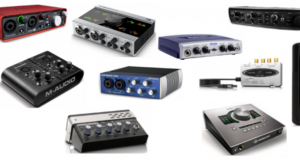
Why would people choose a high-end audio interface over a cheaper one?
Professionals may choose a high-end interface because of its superior audio quality, expanded I/O capacity, improved durability, and long-term reliability.
These features are essential for high-risk recording sessions and professional studio environments.
What are the most recommended audio interfaces for beginning producers?
For beginners, interfaces such as the Focusrite Scarlett series, PreSonus AudioBox, and Behringer UM2 offer great sound quality at a low price point, along with user-friendly operation.
They are highly recommended for those just starting out in music production.
Conclusion
When choosing the interface that best suits your audio needs, evaluate the number of inputs and outputs you need and the type of connectivity you want.
Consider the sound quality you want to achieve and the genre of music you plan to record.
Make sure the interface is compatible with your computer and recording software for a smooth production experience. Types of Audio Interfaces
